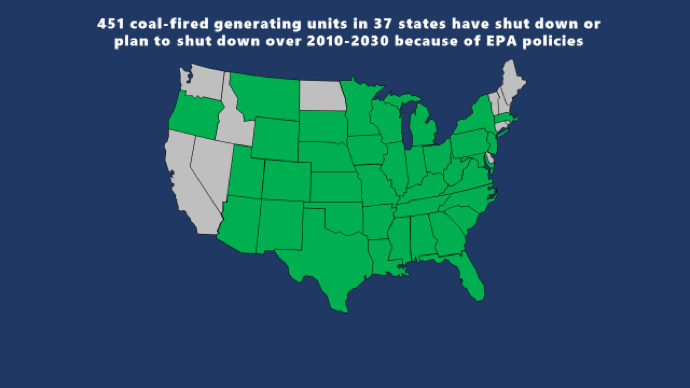A recent report—“Can Coal Make a Comeback?”[i]—asserts that environmental regulations are a secondary influence in decisions to retire coal-fired electric generating units. We disagree with this assertion.
Specifically, the authors of the report “believe” that low natural gas and renewable costs are more important in retirement decisions than environmental regulations.[ii] However, the report provides no analysis to support this belief.
On the other hand, ACCCE has closely tracked the reasons for coal plant retirements over the past five years. While not all retirements have been attributed to environmental regulations, it’s clear from official company statements — including, for example, filings with the Securities and Exchange Commission[iii] and state public utility commissions — that environmental regulations have played a significant role in the vast majority of those retirements. In fact, three-fourths of all coal retirements, so far, have been attributed to EPA regulations.[iv] The map below shows 37 states with a total of 451 coal unit retirements (representing more than 75,000 MW of generating capacity) that have been attributed to EPA regulations.
For example, Northern Indiana Public Service Company stated recently in its integrated resource plan filed with the Indiana Utility Regulatory Commission that two EPA rules promulgated in 2015 (Coal Combustion Residuals and Effluent Limitations Guidelines) “… create a near-term comply/retire decision for coal units: make the required capital investments or retire by the end of 2018 and 2023.” NIPSCO is recommending the retirement of four coal-fired electric generating units.[v]
Many other examples can be found in filings related to EPA’s Mercury and Air Toxics (MATS) rule, which was promulgated in 2012. For example, Georgia Power Company’s 2013 integrated resource plan filed with the Georgia Public Service Commission stated, “Unfortunately, the projected costs to comply with the MATS rule … and other pending environmental regulations have placed significant pressure on the economic viability of several of the Company’s fossil generating units to the point that retirement is the most cost-effective approach.”[vi] Georgia Power Company retired nine coal-fired electric generating units as the result of this IRP.
In summary, we do not dispute the likelihood that non-EPA factors also have had a major influence over some retirement decisions. In fact, according to our analysis, some 24,000 MW of coal retirements have not been attributed to EPA regulations. However, the authors’ belief that environmental regulations exert a secondary influence on coal retirement decisions is contradicted by facts.
[i] Houser, et al., “Can Coal Make a Comeback,” Columbia Center for Global Energy Policy, April 2017.
[ii] Ibid at 22.
[iii] See, for example, American Electric Power, Inc., Form 10-K for the fiscal year ended December 31, 2013, stating in the section “Environmental Controls Impact on the Generating Fleet” the intent of the company to retire 6,533 MW of coal capacity (with unit names and MW capacity).
[iv] ACCCE, Retirement of Coal-Fired Electric Generating Units as of February 25, 2017.
[v] Northern Indiana Public Service Company, 2016 Integrated Resource Plan, November 1, 2016.
[vi] Georgia Power Company, Georgia Power Company’s 2013 Integrated Resource Plan and Application for Decertification of Plant Branch Units 3 and 4, Plant McManus Units 1 and 2, Plant Kraft Units 1-2, Plant Yates Units 4-5, Plant Boulevard Units 2 and 3, and Plant Bowen Unit 6, January 31,2013.

